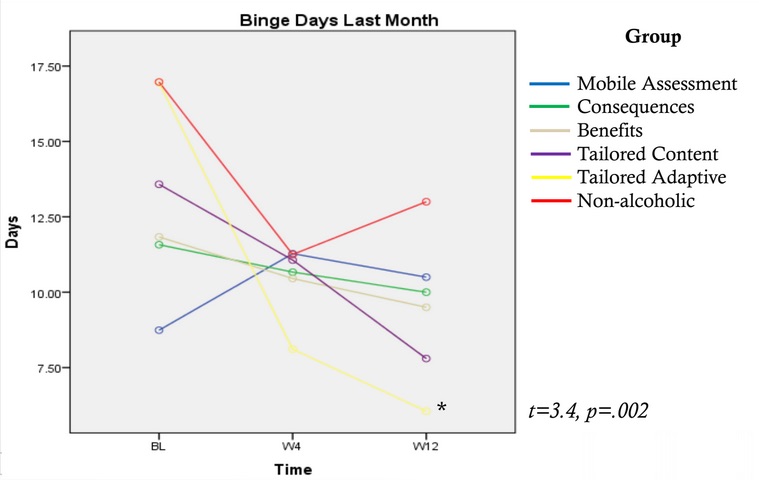 A slide from Fred Muench's presentation shows the effect of different message styles on binge drinking.
A slide from Fred Muench's presentation shows the effect of different message styles on binge drinking.
Evidence continues to emerge that when it comes to text message-based health interventions, not all text messages are created equal. That's the message of two preliminary research presentations -- both text-message-based behavioral interventions focused on problem drinking -- given at the mHealth Summit in National Harbor, Maryland this week.
In one study, presented by Dr. Beth Brock of Brown University, a drinking intervention for community college students proved feasible when the text messages were written by the students' peers. In another study, presented by Fred Muench, a researcher at North Shore Health System, five different text message styles were compared on their ability to influence problem drinking behavior in adults.
Brock looked at a cohort of 62 community college students aged 18 to 22. Half of them were given general motivational text messages, while half received text messages designed by a focus group of students which included safety tips about drinking, driving, and social situations.
"We wanted them to help write the text messages, because we didn’t want them to sound like they were coming from a bunch of middle-aged academics, which is what they would have sounded like if we had written them ourselves," Brock said. "Something that came through from all of the focus groups very strongly was the overarching message: Don’t tell us not to drink, tell us you care how we drink and tell us you care about our safety while we’re drinking."
As such, the results didn't show a decrease in drinking over all; and, Brock argues, they weren't meant to have that effect. But they did show a statistically significant drop in reported negative consequences of drinking (which could include anything from a hangover to a DUI) from 9.45 incidents each down to 3.29 at six week follow-up.
Furthermore, as a feasibility study, the intervention was a success. The text messages had a 95 percent response rate and participants rated the messages highly on average. Brock said this study is important because, unlike residential college students, community college students are a neglected demographic for this kind of work.
"Most of what’s out there in terms of alcohol education, things like alcohol.edu, which are widely used, are used on residential four-year colleges," she said. "Many of those programs refer people’s problems to local on-campus health centers, of which there are few in community colleges. So there are no programs designed for community college students, even though they make up about 40 percent of all US college students."
Muench's work followed up on text messaging research he presented at last year's mHealth Summit, which looked at the effectiveness of positive vs negative messaging. This study had six arms among 120 participants recruited so far (Muench stressed that his data are preliminary results from an ongoing study).
In addition to a control group, there was a group that received consequence-oriented messages, a group that received benefits-oriented messages, and a group that received general motivational messages that weren't about alcohol at all. The other two groups were the tailored text message group, which got messages designed for them based on a prescreening questionnaire, and the tailored adaptive group which received the same but the messages changed based on their answers to a weekly survey. The adaptive groups also had the timing of their messages adjusted to line up with when they were most likely to drink, the factor which Muench believes is responsible for the most significant results of the study.
There are two big trends in the preliminary data. One is a confirmation that, for most outcome measures -- number of heavy drinking days, interest in continuing with the program, overall sense of the intervention's effectiveness, to name a few -- the benefit group did much better than the consequence group.
"The consequence group is not doing that well," Muench said. "Sending people messages about the consequences of something may not be the best strategy. We don’t know how much this is a good idea, because you can mirror these messages perfectly and present the exact same content but it’s positive."
The other trend was that the adaptive tailored group consistently outperformed the other groups, particularly in terms of reducing the number of heavy drinking days for participants. It was also the only group that significantly reduced negative consequences of drinking.
"We really did see the adaptive group doing much better than other groups," he said. "Sending those just in time messages was very, very important."

















